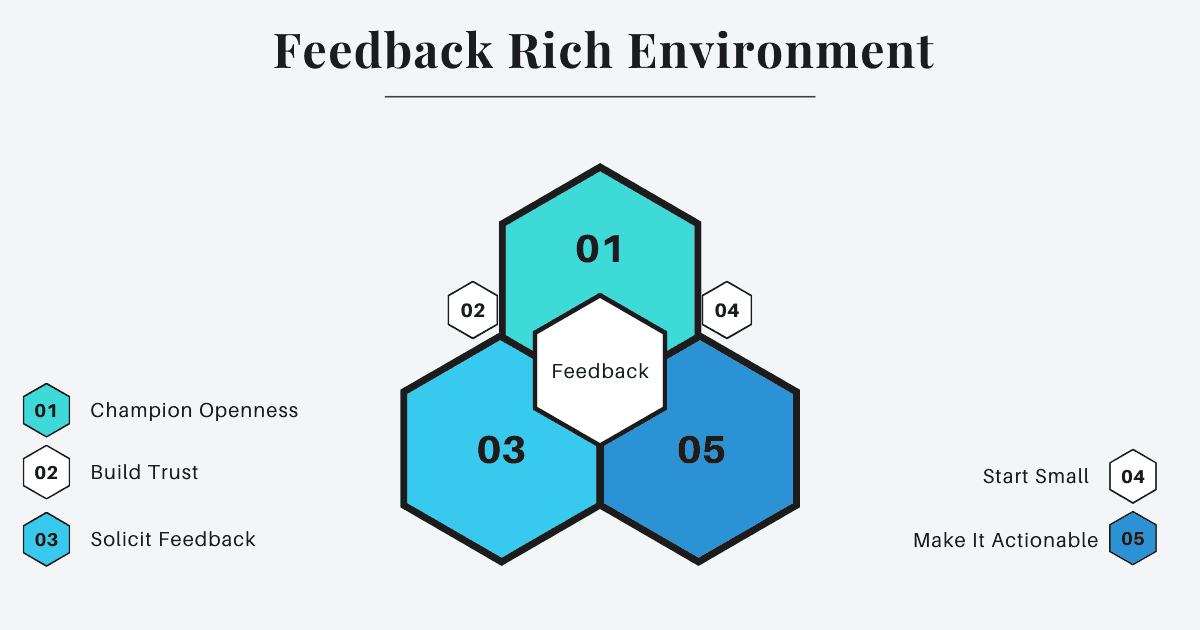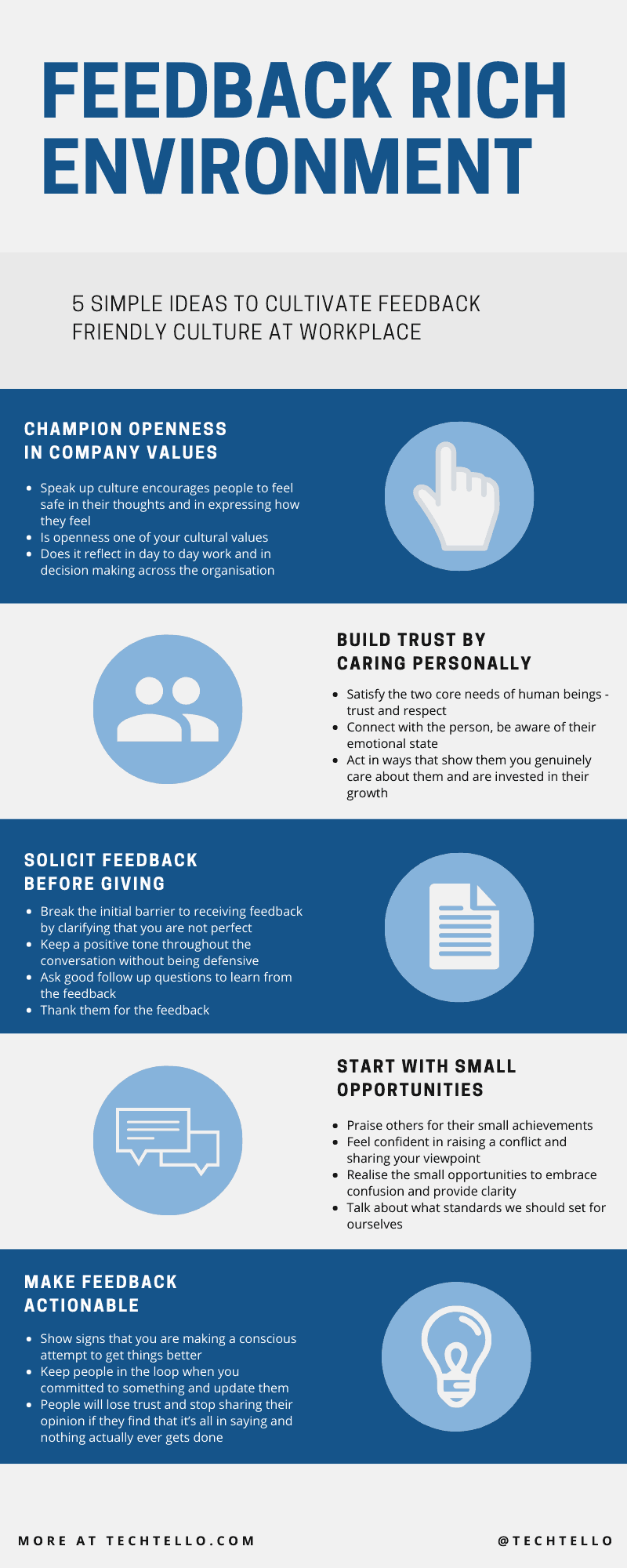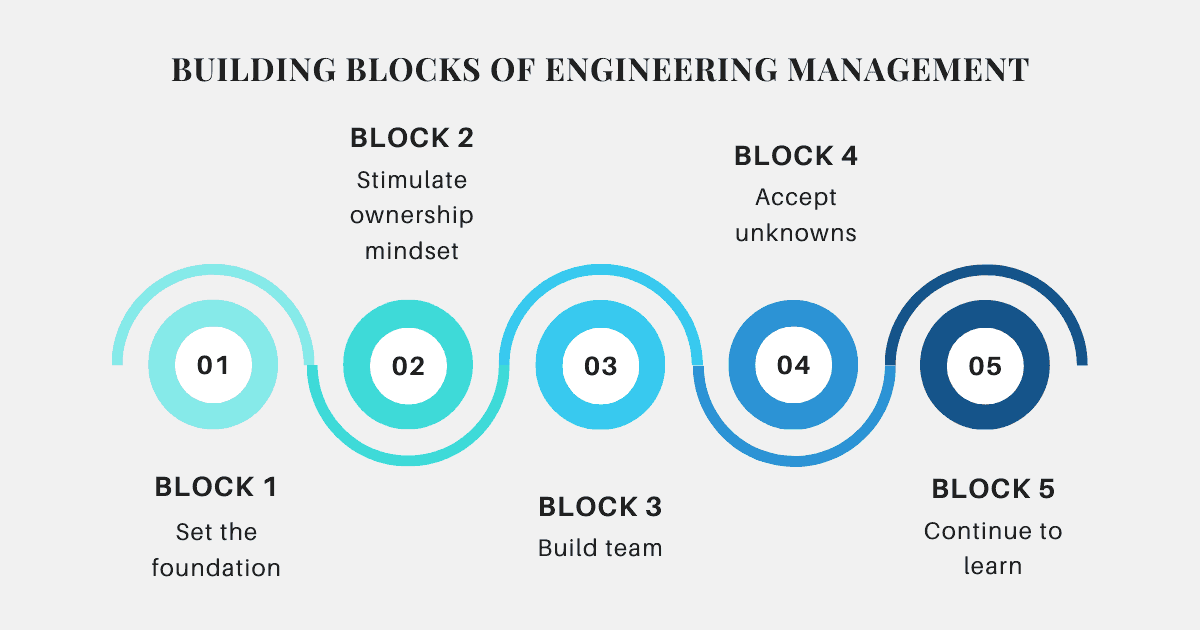How To Create Feedback Rich Environment

Culture in most organisations shape how people work and the results they achieve. Companies that invest in creating a feedback rich environment free people and their minds to focus on their work by taking away the stress of feedback.
When feedback becomes a natural part of a company’s culture, people feel safe to voice opinions, share ideas and find ways to grow by asking “How can I do better”, “How can I help others do better”.
Feedback as a natural instrument to grow people has been identified and adopted by many organisations, but most fail in creating an environment that’s conducive to feedback. The biggest failure lies in the acceptance that feedback is not about the person delivering it, it’s about the receiver, their emotional state, how they perceive it, do they find it worthwhile, do they feel motivated to do better?
Performance reviews and formal one-on-one meetings are good hacks adopted by managers to feel accomplished by ticking an item off their to-do list. Without real understanding of how their actions are perceived and the impact their feedback has on others, they end up doing more disservice to their organisation as they often leave people in a confused state.
Such people fail to realise the full potential of their team, reward exemplary performances and achieve outstanding results.
360 degree feedback is the most powerful tool at our disposal to understand how others view our work and what we can do to improve. Yet, most people pull it out of their toolbox only during the performance review season and forget it exists soon after.
Feedback gathered from peers, colleagues, other teams and functions only during the performance review cycle falls under the trap of recency bias – remembering the most recent event as compared to something that happened a while back. Also, most people are too busy during performance reviews to spend time picking their brains and provide quality feedback to others. The output is low quality and insubstantial data that’s difficult to comprehend and derive any meaningful insight.
Exploiting true value of 360 degree feedback requires building a feedback culture with continuous feedback in which people feel comfortable in directly sharing and seeking feedback from others.
Delivering feedback that doesn’t land in a vacuum

Usefulness of any feedback is in how the receiving party perceives it and the value they derive from it. A good feedback makes people receptive to ideas and opinions that helps them channel their strengths and do away with their weaknesses in an attempt to be better at their jobs.
I find what Douglas Stone and Sheila Heen said in their book Thanks For The Feedback highly insightful, “Receiving feedback sits at the intersection of 2 core human needs – our drive to learn and our longing for acceptance”
I think of feedback as asking these 2 questions:
“How can we work better?”
“How can we improve together?”
Follow these guidelines to learn how to give constructive feedback that creates a path to open feedback culture and motivates people to do better:
Be clear with your intent
Ask yourself what’s the outcome you are trying to achieve through this conversation.
If you commend someone for their work, you want them to know that you appreciate their work and motivate them to continue to do good work. You also want to encourage other team members by setting an example of what good work looks like in the team. Be honest in your praise and do not try to fool others by showing that you care when you clearly don’t.
If your intent is to improve their behaviour or performance, you need to sync up on expectation and reality. Be transparent in describing the situation, translate your observation into the impact and be open minded to hear out the other person.
The magic formula as described in How to Handle Difficult Conversations at Work in 5 Simple Steps requires open-mindedness to agree on the expectations, learn about the gaps and encourage them to find solutions on their own.
Keep it specific
General feedback of the form “good work” or “you are not doing well” does not help the receiver put the feedback into action. It doesn’t describe the experience or states why something matters.
Specificity helps form connections through data to identify and learn about the underlying message of the feedback. Well intentioned specific feedback provides patterns to separate the good from the bad and find answers to these 4 powerful questions:
“What should they continue doing more?”
“What should they stop doing?”
“What should they do less of?”
“What should they start doing?”
Specific feedback is most effective when delivered close to the situation. It should not be about the person but rather an appreciation or criticism of their behaviour and the impact it has on others.
Let’s take this feedback example to understand how communication in feedback makes a huge difference:
“You are bossy in meetings and do not let others speak”
vs
“I want to talk to you about our meeting on metrics review (situation). I noticed that you had some strong points to convey that took a lot of time. Others did not get a chance to express their viewpoint (observation). Team feels that their opinion doesn’t matter while making decisions (impact). What do you think about it? (open-ended question)”
The first one is not constructive feedback as it attacks the person without providing meaningful information. The second way of delivering feedback opens up the person to analyse the situation and engage in problem solving.
Over index on the quality of feedback
Learn about the effectiveness of your feedback through the person receiving it. To understand how the feedback is landing, ask these questions towards the end of discussion:
“Was this conversation useful?”
“Did you feel comfortable during the discussion?”
“What kind of feedback will be most valuable to you?”
“Do you know your action items?”
“Do you have a preference on how we should have such conversations”
5 simple ideas on how to create feedback rich environment at workplace
Creating a feedback culture that gives way to feedback rich environment requires commitment at all levels of the organisation. It starts when employees see leaders of the organisation going beyond the boundaries of the traditional feedback system to care for their people and invest in their growth and success.
A good determinant of the successful feedback rich environment is when employees move from push model to pull.
In a push model, most of the feedback runs down from managers and leaders to their people. In a pull model, feedback is shared naturally between people regardless of their role or level as part of their day-to-day work.
Douglas Stone and Sheila Heen describes pull model very well in their book Thanks For The Feedback,
Creating pull is about mastering the skills required to drive our own learning; it’s about how to recognize and manage our resistance, how to engage in feedback conversations with confidence and curiosity, and even when the feedback seems wrong, how to find insight that might help us grow. It’s also about how to stand up for who we are and how we see the world, and ask for what we need. It’s about how to learn from feedback—yes, even when it is off base, unfair, poorly delivered, and frankly, you’re not in the mood
When people see value in sharing feedback, they will feel invested in their own growth by seeking the same feedback from others creating a self-perpetuating cycle of learning and growth.
Developing a feedback friendly culture requires implementation of different ideas, followed by analysis to identify areas of continuous improvement. Here I have listed a few ideas to get you started on the right path:
Champion openness in company values
Every company has some core principles on which rests the cultural values of the organisation. These are the guiding principles that states what the company stands for, how the company operates, how it makes decisions, how communication happens internally and with the outside world. It has a significant impact on how work happens and how people behave in the organisation.
When leader of a company talks about its values, they need to ask:
“Is it aspirational or reality?”
“Does it reflect in day to day work and in decision making across the organisation?”
“How do others contribute to it?”
“Is openness one of the cultural values?”
The last question is the most important one to create a feedback rich environment. When employees find openness in discussions and do not fear the repercussions of their opinion, they will be more willing to engage in open dialogue.
Speak up culture encourages people to feel safe in their thoughts and in expressing how they feel. It makes employees feel comfortable in giving feedback to anyone in the organisation without worrying how it might land or the impact it may have on their career.
So, ask yourself is openness one of your company values and how does it reflect in day-to-day work.
Build trust by caring personally
Trust and respect are 2 core needs of human beings that must be satisfied before they find it desirable to share their feelings with the other person or take real interest in what they have to say. Without these you may be banging your head against the wall.
You may keep trying with the hope that your efforts will make a difference, but will soon give up as you realise that your words have no impact on them. You may even end up concluding that the other person is unchangeable and don’t care about their own growth.
To build a feedback culture with a feedback rich environment, it’s essential for people to act in ways that earn them others trust and respect. Connect with the person, be aware of their emotional state and act in ways that show them you genuinely care about them and are invested in their growth. Mere words without action have no effect on people.
Solicit feedback before giving
Creating a feedback rich environment starts with you. Do the most difficult part by soliciting feedback first. Put yourself in the hot seat and give the other person a chance to speak.
It may seem awkward at first. Learn to break the initial barrier to receiving feedback by clarifying that you are not perfect and you need feedback like others to do better. Establish vulnerability, talk to them about your mistakes. It will encourage them to open up. Then ask some pointed questions to get started:
“What’s the 1 thing I should do more to help you get better at your work?”
“What’s the 1 thing I should stop doing that impacts you or other team members?”
“Do I provide you with all the necessary information to do your job?”
“How do you feel about your work and the team?”
“Do you feel comfortable reaching out to me?”
“Do you find people in the company approachable. Anything I can help with?”
“Someone in the team told me <some information>. What do you feel about it?”
“What else do you have on your mind worth sharing that can benefit both of us?”
Though extremely difficult, keep a positive tone throughout the conversation without being defensive or feeling the need to justify. Listen actively and ask good follow up questions to learn from the feedback. You can try to make sense of all the information later.
Thank them for the feedback and end the conversation with one last question “Do they see the value in asking the same feedback from others?”. Your openness will encourage them to do the same with their team members and possibly others.
Start with small opportunities
To get to big, start small. Feedback that doesn’t happen on a set routine with the intent to be better at what we do starts small.
It’s in praising others for their small achievements, feeling confident in raising a conflict and sharing your viewpoint, telling others when they screwed up, thanking them for helping out, appreciating their promptness to resolve an issue, going beyond expectations on a task, the list is endless.
Realise the small opportunities to embrace confusion and provide clarity, explain what matters and why it matters, talk about what standards we should set for ourselves. It will create a feedback rich environment which if continued over a long period of time will turn into habit.
Make feedback actionable
Telling people that there’s value in giving and receiving feedback, spending time in having detailed discussions is futile unless it’s put to action. People will soon lose trust and stop sharing their opinion if they find that it’s all in saying and nothing actually ever gets done. It could be an employee complaining about the cumbersome reimbursement process or the way performance review sessions are conducted or how we hire someone.
Showing people that you care about the feedback requires putting it into action. You may not be able to act on 100% feedback, but show signs that you are making a conscious attempt to get things better. Keep people in the loop when you committed to something and update them on the progress.
It will go a long way in establishing trust and getting more people to open up with a desire to provide a better working environment for all.
Recommended Reading
JOIN MY NEWSLETTER
What do you think “Does creating a feedback rich environment start with you”. What are your thoughts? Share with me in the comments below or write to me.






























